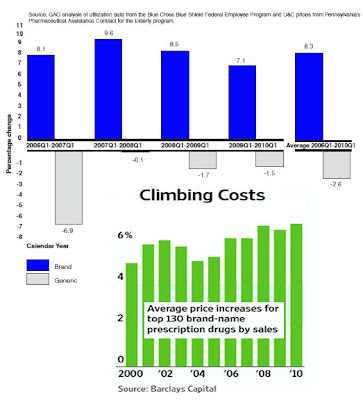Pfizer is Responsible for 18% of My Spam Email!
This @pfizer_news tweet recently came to my attention:"Pfizer, MHRA and partners anti-spam investigation FB page: http://on.fb.me/g5ULdX #realdanger"I have been following Pfizer's campaign against counterfeit drugs for some time (see, for example, "Was a Rat Harmed in the Filming of This Pfizer Commercial?"). This "anti-spam investigation" is the latest phase of that campaign.
The Facebook page offers the report "You've Got Life-Threatening Mail" (find it here), which summarizes a study that involved 65 members of the public who volunteered to donate all their spam emails to the security teams at Pfizer and the MHRA (Medicines and Healthcare products Regulatory Agency -- UK's version of the FDA).
According to the introduction of this report "Spam – or unsolicited mail – is a common way fraudsters target members of the public with black market medicines. In fact, nearly 25% – that’s 15 billion messages – of all spam emails advertise medicines."
"Gareth" -- just one of the "Spam Donors" (watch out for typos there!) -- received 87 spam emails, of which 18% offered medicine. Poor "Dawn" received 228 spam emails, 9% of which offered medicine.
I decided to look in my own spam folder to see if I received any offers for Rx products. That folder currently contains over 4,000 emails (1 week's worth). I searched this folder for any email that mentioned "cholesterol" and found about 27:
I picked one with the subject line "Cholesterol is not just a number." Here's how that message looked:
I wanted to "GET THE FACTS," of course, so I clicked on that and here's the Web site that link lead me to:
The first item on the list -- "Learn About Cholesterol and a Cholesterol-Lowering Treatment" -- brought me to (you guessed it!) this LIPITOR Web page:
It took me a few clicks, but I found that Pfizer is one of those companies responsible for some (OK, maybe NOT 18%) of the SPAM email that I get!
It's ironic that Pfizer is trying to alert consumers about the dangers of spam email when they themselves are responsible for some of this spam. Of course, LIPITOR is not a dangerous counterfeit medication that is offered without a prescription via lipitor.com. Technically, therefore, Pfizer's spam would not qualify to be included in its report on "Life-threatening Mail." But it's still SPAM paid for by Pfizer!
I did a little more investigation to see if I could find out where my spam cholesterol email was coming from.
In the box at the end of the email is a "dotmedia" logo. That lead me to this site. But a note at the bottom of my spam email said "You are receiving this email from InterG Media." The top Google search result on "InterG Media" lead me to this WHOSIS domain registration data:
REGISTRANT CONTACT INFO
InterG Media
Domain Admin
1154 N. Sycamore Ave.
Suite 11
Los Angeles
BILLING CONTACT INFO
Adknowledge
Domain Admin
4600 Madison Ave.
1000
Kansas City
I ignored the REGISTRANT CONTACT and went straight to BILLING CONTACT INFO to find "Adknowledge," the entity that pays the bills. On its website (here) I discovered that Adknowledge claims to be the "leading long tail marketplace." Here's more "About" them:
"Adkowledge, the fourth largest advertiser marketplace, specializes in performance-based marketing solutions utilizing its powerful predictive technology and completely anonymous consumer response patterns to connect advertisers with consumers across multiple channels, including email, search, domains, and social networks. With over 60 terabytes of anonymous consumer behavior data, our proprietary targeting systems run over 20 billion calculations per day to determine what ad to show to each consumer. Over 10,000 advertisers use the Adknowledge ad network to promote their offers."OK. From this, here's how I see Pfizer being a perpetrator of SPAM.
Obviously, the money to pay for my SPAM email has to come directly or indirectly from the marketers of the products advertised, which includes LIPITOR/Pfizer. I don't think Pfizer is paying InterG Media, the entity that supposedly sent me the email. InterG Media is probably just the technical geniuses behind Adknowledge's "predictive technology." No, someone hired Adknowledge -- maybe it was Pfizer itself or maybe it was a "media buyer" hired by Pfizer (or its LIPITOR ad agency of record) to send ads to consumers via the Internet.
What's the lesson learned? When you get SPAM email -- "threatening" or not -- you have to find the "long tail" back to who pays the piper. As Deep Throat said "follow the money."
















